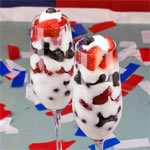
Quince Jelly
(25 servings) Printable Version
- 3 1/2 lbs of quince or 6-7 large (washed with stems removed & quartered-leave skin on)
- 7 cups water
- 4 cups sugar
- 1 wide 6 or 8-quart pan (Stainless steel or copper with stainless steel lining)
- Cheesecloth
- 2 Metal strainers
- Potato masher
- Canning jars
- Candy thermometer
Bring to a boil, reduce heat to simmer, cover and cook for 45 minutes to an hour, until the quince pieces are soft.
With a potato masher, mash the quince to the consistency of slightly runny applesauce. Add more water if necessary. If the mash is too thick, you won't get enough juice out of it.
To strain the juice from the pulp, place a metal strainer over a pot. Drape 2 layers of cheesecloth over the strainer. (Can skip the cheesecloth if you are using a fine mesh strainer). Ladle the pulp into the cheesecloth. You may need to have two strainers set up this way. Let the pulp strain for 3 to 4 hours. If you aren't getting enough juice out of the pulp, you may need to mix more water into the mash.
Measure the amount of juice you have. Should be about 4 to 5 cups. Pour into a thick-bottomed pot on the stove and bring to a boil. Measure out the sugar - a little less than a cup for every cup of juice. Add sugar to the juice.
Bring to a boil, initially stirring constantly, until the sugar is dissolved, so that the sugar does not stick to the bottom of the pan. Insert a candy thermometer to monitor the jelly temperature. As the jelly cooks, skim off the foam that comes to the surface with a spoon.
As the temperature rises above the boiling point of water (212 degrees F), you will notice the consistency of the jelly/juice begins to change. When the temperature is approximately 8 degrees higher than boiling point at your altitude (anywhere from 220 degrees F to 222 degrees F at sea level) the jelly is ready to pour into jars.
Note that candy thermometers aren't always the most reliable indicators of whether or not a jelly is done. Another way to test is put a half teaspoonful of the jelly on a chilled (in the freezer) plate. Allow the jelly to cool a few seconds, then push it with your fingertip. If it wrinkles up, it's ready.
Canning: There are several ways to sterilize your jars for canning. You can run them through a short cycle on your dishwasher. You can place them in a large pot (12 quart) of water on top of a steaming rack (so they don't touch the bottom of the pan), and bring the water to a boil for 10 minutes. Or you can rinse out the jars, dry them, and place them, without lids, in a 200 degrees F oven for 10 minutes.
Use a large ladle to pour the jelly into the sterilized jars to 5/8 inch from the top rim of the jar. Sterilize the lids by letting them sit in just boiled hot water for a few minutes. You will hear a popping noise as a vacuum seal is created as the jars of jelly cool.)
Makes 4-6 cups of jelly.
Quince is a fruit that's related to apples and pears. It has a tart flavor that mellows when cooked which makes it good to use in jams and marmalades.
Mr Breakfast would like to thank mrbreakfast_lvr for this recipe.
Comments About This Recipe
What do you think of Quince Jelly?
There are no comments yet for this recipe. Be the first! Was it good? Was it bad? Did you make it better somehow? Let the world know!What do you think of Quince Jelly?
Connect With Mr Breakfast:
Home | About | Contact | Breakfast Recipes | The Cereal Project | Site Index | Food Charities | Blog
©2025 MrBreakfast.com
©2025 MrBreakfast.com






